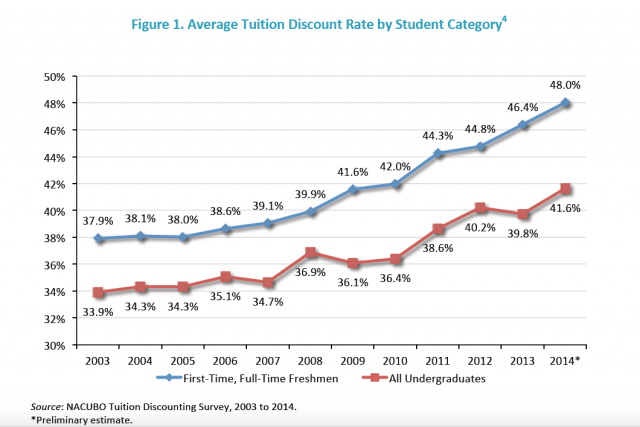On Tuesday, Inside Higher Ed published an article discussing the impact of rising discount rates across higher education institutions. The article hinges on the data shown in the chart below. It indicates discount rates now average 48.6% for first-time freshman and 42.5% for all undergraduates. These rates are at all time highs.
While the stance of the article is neutral, the comments are certainly not. Some argue this is a sign of the end of higher ed as we know it, while others cite that increasing the discount rates is a common practice with few negative ramifications.
My Take on the Issue
The truth is, both camps are somewhat right. However, the real issue at hand is not the discount rate — defined as institutional grant dollars as a percentage of gross tuition and fee revenue — but rather its impact on net tuition — the total cost of one year of a college education minus any grant aid or other monetary incentives one might receive. Historically, an institution could raise the discount rate to spur enrollment, yielding an overall increase in net tuition.
Unfortunately, the data show this relationship no longer holds true.
As cited in the article, “Net tuition revenue growth estimates averaged 1.2 percent for freshmen in 2015-16, flattening slightly from 2.1 percent a year earlier... Net revenue increases weren’t enough to keep pace with the rate of inflation as measured by the Higher Education Price Index, which was 2.1 percent in 2015. At the same time, many private institutions have experienced declining enrollments...More than half of institutions, 51.2 percent, reported a decrease in total undergraduate enrollment, and 53.5 percent said freshman enrollment dropped.”
Not only is increasing the discount rate not delivering an increase in enrollment, it is also introducing additional risk to the quality of the institution going forward.
To explain, the yield and retention rate are generally lower for applicants acquired through typical enrollment boosting efforts. This is due to two factors. First, applicants will “price shop” and select the school which offers the greatest amount of incentives, rather than selecting a school which is the best fit for them. Second, schools may lower their standards for a given class in order to meet a certain quota.
Universities' Response: Online Programs
In response, schools are looking to new ways to increase net tuition, primarily in the domain of student recruitment and retention efforts. As cited in the Inside Higher Ed article, “Student recruitment and retention made up the top strategy, used by 27.7 percent of institutions”.
Traditionally retention and recruitment strategies can consist of expensive, high-touch, person intensive methods, such as holding in-person recruiting and summer programs across the country. While effective, these fail to scale in an efficient manner. A more modern method relies on digital marketing techniques with activities such as buying contact lists of prospective students and sending informational content via email, direct mail, and advertisements. This method scales nicely, but often lacks authenticity and quality to resonate with prospective students.
Today, many organizations are looking to online learning and custom learning experiences to drive retention and recruitment strategies. These online learning platforms offer not only scale, but also a unique and compelling message that resonates with students in a positive reflection of the institution. Additionally, content and pedagogies developed for these online programs can be reused for different audiences and different recruiting classes. More information on these programs can be found here.
Summary
In summary, the important metric to watch is net tuition revenue, more so than discount rates or enrollment. Additionally, the strategies influencing net tuition revenue are changing. As such, institutions “must redesign their business model to be prosperous in the future,” as Rick Beyer, a former president of Wheeling Jesuit University and a consultant who is the managing principal of AGB Institutional Strategies, says.
It is also important to remember that institutions have long displayed resilience and have an incredible ability to be imaginative. We expect these same traits, along with the incorporation of online strategies, to carry them forward in the future.
Do you want to learn how Universities are using Customized Learning Experiences to drive net tuition revenue? Access our white paper now.
About us:
ExtensionEngine specializes in building customized learning experiences, offering innovating online and blended-learning programs. We have extensive experience with adaptive learning, personalized learning, and competency based learning programs. Last year we had 70+ product launches for some 40 clients including elite universities, corporations and foundations...programs that touched millions of learners.
If you’re interested in learning about how Custom Learning Experiences can supercharge your online learning programs:




